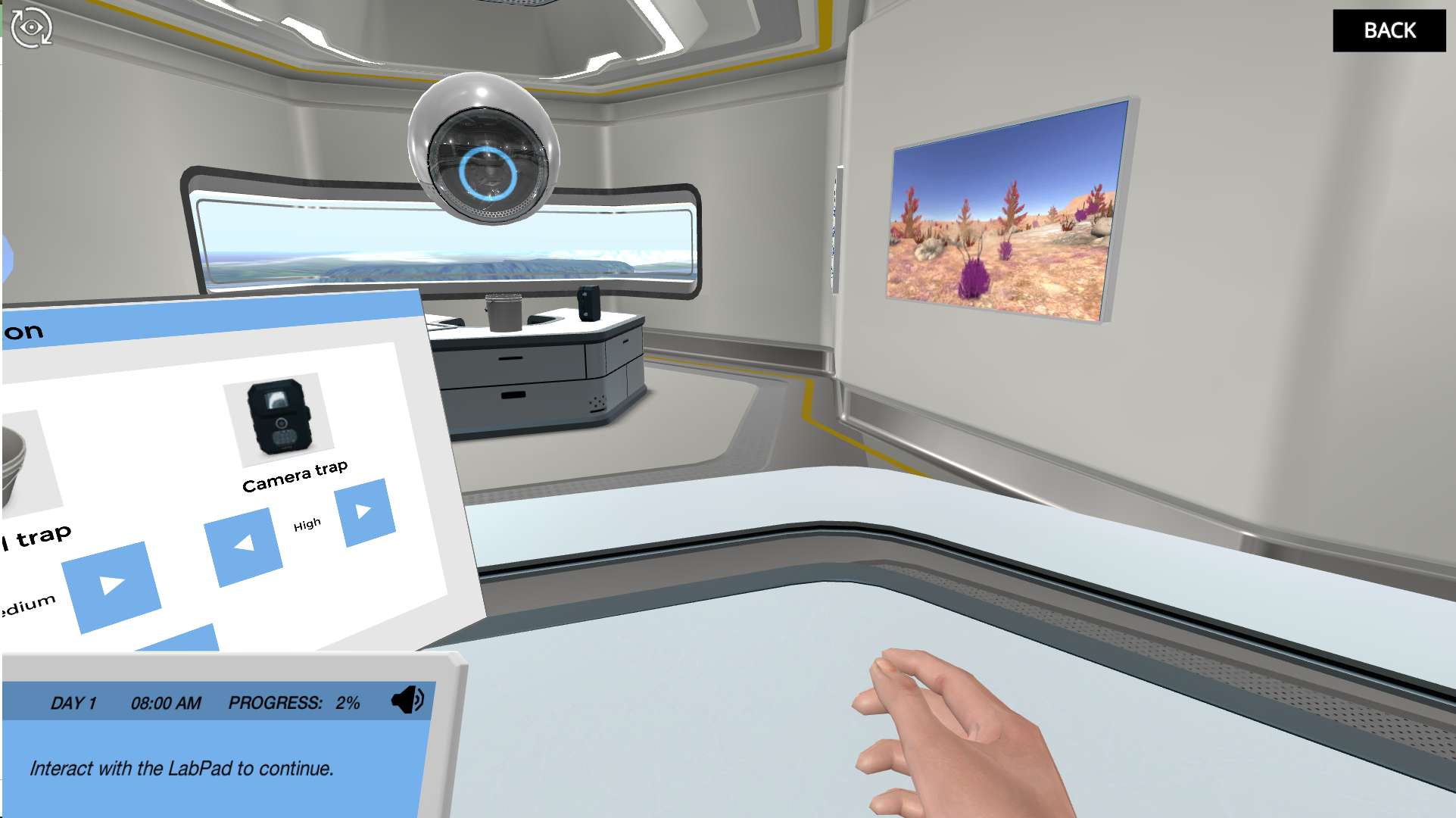Heading 1
Heading 2
Heading 3
Heading 4
Heading 5
Heading 6
Lorem ipsum dolor sit amet, consectetur adipiscing elit, sed do eiusmod tempor incididunt ut labore et dolore magna aliqua. Ut enim ad minim veniam, quis nostrud exercitation ullamco laboris nisi ut aliquip ex ea commodo consequat. Duis aute irure dolor in reprehenderit in voluptate velit esse cillum dolore eu fugiat nulla pariatur.
Block quote
Ordered list
- Item 1
- Item 2
- Item 3
Unordered list
- Item A
- Item B
- Item C
Bold text
Emphasis
Superscript
Subscript
About This Simulation
Travel to the exoplanet Astakos IV and use ecological methods to assess and compare biodiversity over time and between different sites.
Learning Objectives
- Sample for biodiversity
- Use Quadrat, camera trap and Pitfall traps
- Assess and compare biodiversity using the biodiversity index.
- Identify species with a dichotomous key
- Prioritize sampling
About This Simulation
Lab Techniques
- Elevational biodiversity gradient
- Pitfall trap
- Biodiversity index
- Camera trap
- Quadrat
Related Standards
- High level content, could support HS-LS2-2, HS-LS2-7
- High level content,could support Big Idea 4: Systems interactions
- 4.1 Species, communities and ecosystems
- C.4 Conservation of Biodiversity
Learn More About This Simulation
Wherever you look, nature is full of animals, plants and other organisms. In this simulation, you will learn basic methods to assess and compare biodiversity.
Explore the biodiversity on an exoplanet
No matter where you live, we can guarantee you that the organisms you will find in on the exoplanet Astakos IV will be alien and new to you! In this simulation, you will sample biodiversity in three different locations, from the desert lowlands to a forest in the mountains. Once back in the lab, you will use a dichotomous key to identify species, and compare the biodiversity between the three different sites.
Sample and identify organisms
In a virtual world, you can explore an entire planet without ever physically moving. In this virtual lab simulation, you get to explore three different biotopes to sample for biodiversity. In just 30 minutes you will learn how to collect and identify species. You can collect images with a camera trap and critters in a pitfall trap in a matter of minutes – something that would normally take hours or weeks to do!
Compare and asses biodiversity
At the end of the simulation, you will compare the biodiversity of the three different sites by using the biodiversity index. You will compare the elevational biodiversity gradient on the exoplanet with that found on earth. Will you be able to identify the alien species?
For Science Programs Providing a Learning Advantage
Boost STEM Pass Rates
Boost Learning with Fun
75% of students show high engagement and improved grades with Labster
Discover Simulations That Match Your Syllabus
Easily bolster your learning objectives with relevant, interactive content
Place Students in the Shoes of Real Scientists
Practice a lab procedure or visualize theory through narrative-driven scenarios


FAQs
Find answers to frequently asked questions.
Heading 1
Heading 2
Heading 3
Heading 4
Heading 5
Heading 6
Lorem ipsum dolor sit amet, consectetur adipiscing elit, sed do eiusmod tempor incididunt ut labore et dolore magna aliqua. Ut enim ad minim veniam, quis nostrud exercitation ullamco laboris nisi ut aliquip ex ea commodo consequat. Duis aute irure dolor in reprehenderit in voluptate velit esse cillum dolore eu fugiat nulla pariatur.
Block quote
Ordered list
- Item 1
- Item 2
- Item 3
Unordered list
- Item A
- Item B
- Item C
Bold text
Emphasis
Superscript
Subscript
A Labster virtual lab is an interactive, multimedia assignment that students access right from their computers. Many Labster virtual labs prepare students for success in college by introducing foundational knowledge using multimedia visualizations that make it easier to understand complex concepts. Other Labster virtual labs prepare learners for careers in STEM labs by giving them realistic practice on lab techniques and procedures.
Labster’s virtual lab simulations are created by scientists and designed to maximize engagement and interactivity. Unlike watching a video or reading a textbook, Labster virtual labs are interactive. To make progress, students must think critically and solve a real-world problem. We believe that learning by doing makes STEM stick.
Yes, Labster is compatible with all major LMS (Learning Management Systems) including Blackboard, Canvas, D2L, Moodle, and many others. Students can access Labster like any other assignment. If your institution does not choose an LMS integration, students will log into Labster’s Course Manager once they have an account created. Your institution will decide which is the best access method.
Labster is available for purchase by instructors, faculty, and administrators at education institutions. Purchasing our starter package, Labster Explorer, can be done using a credit card if you are located in the USA, Canada, or Mexico. If you are outside of North America or are choosing a higher plan, please speak with a Labster sales representative. Compare plans.
Labster supports a wide range of STEM courses at the high school, college, and university level across fields in biology, chemistry, physics, and health sciences. You can identify topics for your courses by searching our Content Catalog.


















